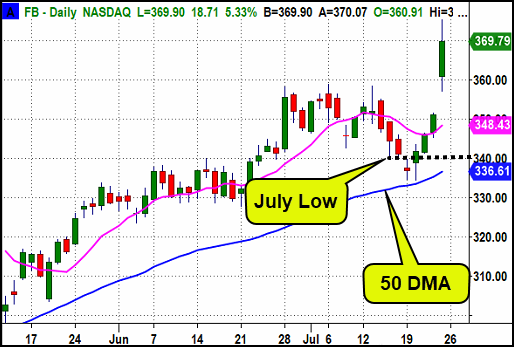July often sets up conditions for late summer rallies, as well as significant tops. As a result, July can be a frustrating and confusing period. Last week was a good example of why. I’ll start with the bearish case…
- Market Price Action - The market’s price action coming into last week set up the market indexes for a weak Monday, and weekend reports of rapidly increasing (and breakthrough cases) of the COVID Delta variant provided the news for a “news follows the markets Monday plunge.” In other words, the market was beginning to roll over before Monday, but it needed a more identifiable reason to make it obvious.
- Seasonal High Timeframe - Mid-July is a seasonal high timeframe, so the markets’ weakness coming into last Monday furthered the bear’s case for being cautious (if not down-right bearish) during last Monday’s sell-off.
- Bearish Risk Gauges - Our Risk Gauges were bearish, and several of the general stock indexes had bearish momentum readings suggesting breaks of support would lead to further declines. With such a bearish list of conditions, why didn’t the market follow through to the downside, and how could you have trusted the rally would continue?
Traders who rely on the fundamentals could make the bullish case that earnings season is going well.
For example, Barron’s published:
“Some 88.3% of S&P 500 companies have beat their earnings forecasts—even more than over the past four quarters—while a ridiculous 84.2% have topped analysts’ expectations, compared with an average of 73.7% over the past four quarters. It’s hard to be bearish against that kind of backdrop.”
It’s a good point, but the markets can often have a surprising view of what the future holds. So, we keep a closer eye on what the market is doing with the technicals, and as mentioned above, July can be a very pivotal month.
July may get its significance from the fact that it begins the second half of the year, it hosts an earnings season or some other reason.
In short, we give the market a couple of weeks to establish a range that begins the second half of the year. Then we trade based on the patterns that develop in and around this range. One example is to trade the low of the range for either a reversal low or a significant breakdown.
For the purposes of last week
This year, the lower bound of the big range occurred on July 8 in SPY, DIA, and IWM, and July 1 for QQQ.
The chart below of the QQQ demonstrates how this “Calendar Range Low” is exactly where the market stopped and reversed.

I’ll explain why you might have expected this level to hold shortly, but first…
Below you’ll see a chart of the SPY with its July low noted.

SPY and DIA broke their July lows, but they didn’t “continue” (or confirm the breakdown).
So on Tuesday, with QQQ bouncing off its level like a trampoline and the SPY forming a reversal pattern, the stage was set for a rally.
Don’t argue with the generals until they breakdown
However, the biggest indicator that the market was not ready to break was that the “Generals” (as I’ll call them for this article) didn’t show any signs of breaking July lows.
These Generals are Apple (NASDAQ:AAPL), Amazon.com (NASDAQ:AMZN), Microsoft (NASDAQ:MSFT), Facebook (NASDAQ:FB), Alphabet Inc Class C (NASDAQ:GOOG).
Collectively they make up 47% and over 21% of the market capitalization of the QQQ and SPY, respectively. It will be very hard to have a big correction in the SPY or QQQ without their participation. I encourage you to look at these stocks with the perspective of the July low. Since you don’t know the exact formula for the July low, I’ve included FB’s chart below. The other stocks are obvious.

Of course, the market is not just 5 stocks, and there are some serious market corrections underway. For example, the Russell 2000 (IWM) has not had a good July.
This and a host of other conditions covered in last week’s highlights and weekly videos give us good reason to be careful in how and where we place our bullish bets.
Last week’s market highlights:
- We were moving to Risk-On in SPY, while IWM was underperforming the other major indices last week by a wide margin and remained Risk-Off
- QQQ, SPY and DIA were all continuing their bullish phases, making new closing all-time highs
- Momentum was still diverging from price across all major indices, indicating that a hypothetical break in current bullish trends could spell a significant drawdown
- Market internals still showed that the number of underlying stocks in the major indices were not participating in the bullish action, as indicated by the McClellan Oscillator and Real Motion
- Volume patterns remained weak with zero accumulation days for both NASDAQ 100 and the IWM
- Volatility was somewhat flat, with the spike over the past couple of days being reversed, indicating that fear was out of the market
- SPY’s underlying stocks were indicated as oversold to start the week, but stabilized and performed well the remainder of the week, while IWM continued to look weak with the potential to keep sinking
- Soft Commodities (DBA), Copper (CPER), and Energy (USO/(UNG) all performed well for the week
- Long Bonds (TLT) held the 200 DMA, with Real Motion showing positive momentum readings working back from a slight overbought situation
- Growth Stocks continued their strong performance while Value was continuing to lag under the 50 DMA
- Biotech (IBB) looked to be the strongest member of the Modern Family last week, defying the early week selloff and looking for a further upwards move as the COVID-19 Delta variant got worse
- Half of the members of the Modern Family were underperforming SPY and were in strong warning phases
- Emerging Markets (EEM) seemed to have been hit hard by recent COVID news, breaking below its 200 DMA for the first time in over a year
- Homebuilders (XHB) was one of the strongest sectors, notably broke over its 50 DMA, and closed a new swing high.
- USD continued its pattern of marching in lockstep with TLT as it has done since TLT’s uptrend became obvious in early June
Cryptocurrency highlights
- Bitcoin failed 30k support on Monday, dropping all the way down near 2021 lows around $29,300 which caused bearish sentiment to emerge. There were expectations for BTC to test support all the way down to 20k, but as you’ll read below, there’s reason to look for a bottom here.
- Binance reported the biggest bid ever recorded on their order book for Bitcoin at the $30,000 level, signaling massive support that helped the crypto market rally for the remainder of the week.
- As of the time of writing, BTC had recovered 7% vs. 15% for ETH over the last 7 days, likely due to anticipation for a major Ethereum Network upgrade that is scheduled for Aug. 4.
- Anticipation of harsh regulatory action in the Western world seemed to be waning as major financial service providers such as Visa (NYSE:V) and Mastercard (NYSE:MA) made major investments into blockchain and crypto services, as well as tech and commerce companies such as Amazon and Google (NASDAQ:GOOGL).
- You can look for long-term support for Bitcoin at the $29,300 level and resistance at $36,000.
- As shown in the chart below, short-term Real Motion (50/10) continued to indicate that BTC's momentum was not as bearish as price action suggested. BTC's third bounce from below 30k in as many months resulted in another daily bullish divergence and strengthened the bullish divergence pattern as measured by the 10 and 50-day moving averages. A significant move over 33k could lead to a surprising rally.

